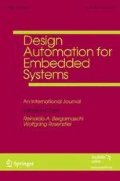Abstract
Mobile device users tend to extend the device’s usage time by checking the battery level frequently via the battery level indicator (BLI) and adjusting their device usage patterns. This behavior is based on the assumption that the BLI is accurate. In this paper, we define four requirements that a user would expect for the BLI and define BLI anomalies that violate these requirements. We found various kinds of BLI anomalies in commercial smartphones. The key cause of a BLI anomaly is that the battery state changes dynamically depending on various factors, yet the existing BLI system is limited in delivering the battery status adequately. To address this problem, we propose a new BLI that defines the battery capacity as active, spare, and dead. The experiment results for the commercial smartphones show that with the proposed BLI system, BLI anomalies are removed, and accurate battery information is delivered to users.










Similar content being viewed by others
References
Truong KN et al (2010) The design and evaluation of a task-centered battery interface. In: Proceedings of the 12th ACM international conference on ubiquitous computing, pp 341–350
Rahmati A, Zhong L (2009) Human–battery interaction on mobile phones. Pervas Mobile Comput 5(5):465–477
Ferreira D et al (2013) Revisiting human–battery interaction with an interactive battery interface. In: Proceedings of the 2013 ACM international joint conference on pervasive and ubiquitous computing, pp 563–572
Rahmati A et al (2007) Understanding human–battery interaction on mobile phones. In: Proceedings of the 9th international conference on human computer interaction with mobile devices and services, pp 265–272
Ferreira D et al (2011) Understanding human–smartphone concerns: a study of battery life. In: Proceedings of the international conference on pervasive computing, pp 19–33
Aris AM, Shabani B (2017) An experimental study of a lithium ion cell operation at low temperature conditions. Energy Procedia 110:128–135
Ouyang D et al (2019) Influence of low temperature conditions on lithium-ion batteries and the application of an insulation material. RSC Adv 9(16):9053–9066
Stand-alone Model Gauge m5 Fuel Gauge with SHA-256 Authentication. https://datasheets.maximintegrated.com/en/ds/MAX17201-MAX17215.pdf
Broussely M et al (2005) Main aging mechanisms in Li ion batteries. J Power Sources 146(1–2):90–96
Li D, Danilov DL, Bergveld HJ, Eichel R-A, Notten PHL (2019) Understanding battery aging mechanisms. In: Future lithium-ion batteries. Royal Society of Chemistry, London, pp 220–250
Juang LW et al (2015) Coulomb counting state-of-charge algorithm for electric vehicles with a physics-based temperature dependent battery model. Proc IEEE Energy Conv Cong Expos (ECCE) 2015:5052–5059
Ng KS et al (2009) Enhanced coulomb counting method for estimating state-of-charge and state-of-health of lithium-ion batteries. Appl Energy 86(9):1506–1511
Jeong Y-M et al (2014) Enhanced Coulomb counting method with adaptive SOC reset time for estimating OCV. Proc IEEE Energy Conv Cong Expos (ECCE) 2014:1313–1318
Roscher MA, Sauer DU (2011) Dynamic electric behavior and open-circuit-voltage modeling of LiFePO4-based lithium ion secondary batteries. J Power Sources 196(1):331–336
Lee S et al (2008) State-of-charge and capacity estimation of lithium-ion battery using a new open-circuit voltage versus state-of-charge. J Power Sources 185(2):1367–1373
Yu M et al (2008) Theory and implementation of impedance track battery fuel-gauging algorithm in bq2750x family. Texas Instruments Application Report-SLUA450
He L et al (2019) Environment-aware estimation of battery state-of-charge for mobile devices. In: Proceedings of the 10th ACM/IEEE international conference on cyber-physical systems, pp 227–236
Rahimi-Eichi H et al (2013) Online adaptive parameter identification and state-of-charge coestimation for lithium-polymer battery cells. IEEE Trans Ind Electron 61(4):2053–2061
Shrivastava P et al (2019) Overview of model-based online state-of-charge estimation using Kalman filter family for lithium-ion batteries. Renew Sustain Energy Rev 113:109233
Zhang C et al (2018) Online estimation of battery equivalent circuit model parameters and state of charge using decoupled least squares technique. Energy 142:678–688
Sangwan V et al (2016) Equivalent circuit model parameters estimation of li-ion battery: C-rate, soc and temperature effects. In: Proceedings of the 2016 IEEE international conference on power electronics, drives and energy systems (PEDES), Trivandrum, Kerala, India, pp 1–6
Hu X et al (2012) A comparative study of equivalent circuit models for Li-ion batteries. J Power Sources 198:359–367
Verbrugge M, Tate E (2004) Adaptive state of charge algorithm for nickel metal hydride batteries including hysteresis phenomena. J Power Sources 126(1–2):236–249
Guo X et al (2016) Joint estimation of the electric vehicle power battery state of charge based on the least squares method and the Kalman filter algorithm. Energies 9(2):100
Lee J et al (2007) Li-ion battery SOC estimation method based on the reduced order extended Kalman filtering. J Power Sources 174(1):9–15
He H et al (2011) State-of-charge estimation of the lithium-ion battery using an adaptive extended Kalman filter based on an improved Thevenin model. IEEE Trans Veh Technol 60(4):1461–1469
Wan EA, Van Der Merwe R (2000) The unscented Kalman filter for nonlinear estimation. In: Proceedings of the IEEE 2000 adaptive systems for signal processing, communications, and control symposium (Cat. No. 00EX373), pp 153–158
Guo F et al (2019) A multi-scale parameter adaptive method for state of charge and parameter estimation of lithium-ion batteries using dual Kalman filters. Energy 178:79–88
Ye M et al (2018) A double-scale and adaptive particle filter-based online parameter and state of charge estimation method for lithium-ion batteries. Energy 144:789–799
Author information
Authors and Affiliations
Corresponding author
Additional information
Publisher’s Note
Springer Nature remains neutral with regard to jurisdictional claims in published maps and institutional affiliations.
This work was supported by National Research Foundation of Korea (NRF) (Grant Nos. NRF-2019R1A2C2004619, NRF-2017M3C4A7083677), and Institute for Information and Communications Technology Promotion (IITP) Grant funded by the Korea Government (MSIT) (No. 2018-0-00532, Development of High-Assurance (≥ EAL6) Secure Microkernel).
Rights and permissions
About this article
Cite this article
Jeon, S., Kim, D., Ahn, J. et al. Revisiting the battery level indicator of mobile devices. Des Autom Embed Syst 25, 65–85 (2021). https://doi.org/10.1007/s10617-021-09246-w
Received:
Accepted:
Published:
Issue Date:
DOI: https://doi.org/10.1007/s10617-021-09246-w




